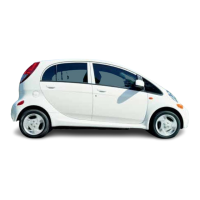Chapter 2 Part D General engine overhaul procedures 2D-23
18.6 Measure the diameter of each crankshaft journal at several
points to detect taper and out-of-round conditions
(see illustration).
By measuring the diameter at a number of points
around each journal’s circumference, you’ll be able to determine whether
ornotthejournal isout-of-round.Takethemeasurementateachendofthe
journal, near the crank throws, to determine if the journal is tapered.
7 ifthecrankshaftjournalsaredamaged, tapered, out-of-roundorworn
beyond the limits given in the Specifications, have the crankshaft re-
ground by an automotive machine shop. Be sure to
use
the correct size
bearing inserts if the crankshaft is reconditioned.
c
8 Check the oil seal journals at each end of the crankshaft for wear and
damage. If the seal has worn a groove in, the journal, or if it’s nicked or
scratched
(see illustration),
the new seal may leak when the engine is
reassembled. In sbmecases, an automotive machine shop may be able to
repair the journal by pressing on a thin sleeve. If repair isn’t feasible, a new
or different crankshaft should be installed.
9 Refer to Section 19 and examine the main and rod bearing inserts.
19 Main and connecting rod bea’rings - inspection
Refer to illustration 19.1
1 Even though the main and connecting rod bearings should be re-
placed with new ones during the engine overhaul, the old bearings should
be retained for close examination, as they may reveal valuable informa-
tion about the condition of the engine
(see illustration).
2 Bearing failure occurs because of lack of lubrication, the presence of
dirt or other foreign particles, overloading the engine and corrosion. Re-
gardless of the cause of bearing failure, it must be corrected before the
engine is reassembled to prevent it from happening again.
3 When examining the bearings, remove them from the engine block,
the main bearing caps, the connecting rods and the rod caps and lay them
out on a clean surface in the same general position as their location in the
engine. This will enable you to match any bearing problems with the corre;
sponding crankshaft journal.
4 Dirt and other foreign particles get into the engine in avariety of ways.
it may be left in the engine during assembly, or it may pass through filters or
the PCV system. It may get into the oil, and from there into the bearings.
Metal chips from machining operations and normal engine wear are often
present. Abrasives are sometimes left in engine components after recon-
ditioning, especially when parts aren’t thoroughly cleaned using the prop-
er cleaning methods. Whatever the source, these foreign objects often
end up embedded in the soft bearing material and are easily recognized.
Large particles won’t embed in the bearing and will score or gouge the
bearing and journal. The best prevention for this cause of bearing failure is
to clean all parts thoroughly and keep everything spotlessly clean during
engine assembly. Frequent and regular engine
bil
and filter changes are
also recommended.
18.8 if the seals
have
worn grooves
In
the crankshaft journals,
or if the seal contabt surfaces are nicked or scratched, the new
seals will leak
FATIGUE FAILURE
SCRATCHES
DIRT IMBEDDED
INTO BEARING MATERIAL
SCRATCHED BY DIRT
SECTIONS
IMPROPER SEATING
WIPED OUT
LACK OF OIL
mm
FROM ENTIRE SURFACE
EXCESSIVE WEAR TAPERED JOURNAL
19.1 Typical bearing failures
5 Lackof lubrication (or lubrication breakdown) hasanumberof interre-
lated causes. Excessive heat (which thins the oil), overloading (which
squeezes the oil from the bearing face) and oil leakage or throw off (from
excessive bearing clearances, worn oil pump or high engine speeds) all
contribute to lubrication breakdown. Blocked oil passages, which usually
are the result of misaligned oil holes in a
bearing shell, will also oil starve a
bearing and destroy it. When lack of lubrication is the cause of bearing fail-
ure, the bearing material is wiped or extruded from the steel backing of the
bearing. Temperatures may increase to the point where the steel backing
turns blue from overheating.
6 Driving habits can have a definite effect on bearing life. Full throttle,

